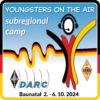With barely enough time to recover from the intercultural evening, the second day was kicked off with a presentation about South Africa, giving us an overview about this amazing country that we are barely able to witness otherwise, due to all the other activities planned!
Next up was the BACAR payload building. The five teams that everyone was split into yesterday came together for planning the project, selecting the components, building the payload, and modifying the software to fit their needs.
After lunch then came the first highlight of the payload building: The drop test. To ensure that all payloads survive the landing, each team had to drop their cube from several meters high onto hard ground. Fortunately, all team’s cubes survived that test, with only minor problems uncovered, which could fixed right after.
With the drop test sorted out, it was time for the second, important test: The shake test. Attached to the end of a broomstick, the payloads were swung and shook around, ensuring that both the ropes attaching them and the cubes themselves survive the possibly very violent wind conditions that can occur during their journey. As it turned out, the biggest bottleneck uncovered during the test was the connection between the broomstick and the ropes, sending some cubes flying through the room.
In the afternoon, we were given a presentation about South Africa’s first amateur radio satellite, Kletskous 1, including an explanation of both the transponder and stabilisation design. The current transponder prototype will also launch with the balloon on Sunday! To finish off the afternoon, there also was a presentation about how to actually work the satellites that are already out there circling our planet.
To finish off Friday, we had another session of the “Train the Trainer” theme. This time, we were sent off rather early, to catch some sleep for the big day coming up.
To start off the BACAR day, we all had to get up to 4AM, so we could arrive in Secunda around 6AM. When we arrived, it was literally freezing outside. When we were told before the camp that it was going to be 5 degrees outside at night, we definitely were thinking about +5!
After some warm soup and the sun coming up, some people made final preparations for the payloads, while the rest watched the balloon being set up and filled with hydrogen. When the balloon was filled up and started wobbling around due to the strong winds, the payloads were already lined up, so the balloon could be attached and let go, speeding off and almost hitting bystanders with the long chain of payloads hanging off of it.
Without losing time, we drove to the base station, the Secunda Radio Club clubhouse. From there, we tried to receive the signals from the various payloads, working through a list of exercises given beforehand. Even though some of the hardware on the balloon failed, there were still plenty of signals left to chase after with out antennas and radios.
With the payload landed and the chase team still underway, we had some time to fill. Armed with the antenna from Thursday and the knowledge from Friday’s presentation, we took chase on the satellites that happened to come by. Those transponders sure were kept busy during that time.
During the downtime, we were also given a practical demonstration of RaDAR – Rapid Deployment of Amateur Radio. Within a few minutes there were several antennas set up, and used for making QSOs with a portable rig.
In the early afternoon, the chase cars came back, with the payloads in the trunk. This meant that the time for enjoying the sun was over, and we went back to work, trying to get the data collected during flight, as well as preparing the presentations for later. Unfortunately, it turned out that none of the teams had GPS data from the complete flight, and one even lost their complete flight data due to an unknown issue.




